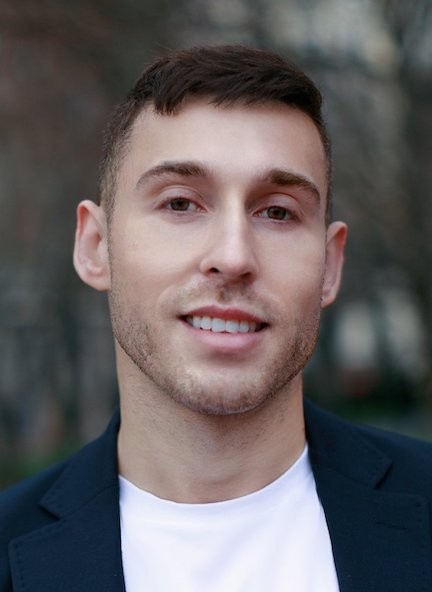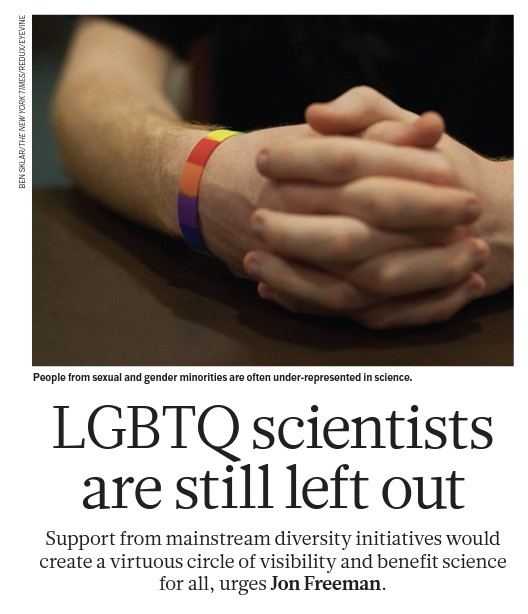Faculty Profile: Jon Freeman
Jon Freeman, Associate Professor of Psychology, spoke with us about his research as well as his LGBTQ+ advocacy work in STEM.
Tell us about your background and upbringing and your path to your current career.
I think it’s likely that aspects of growing up gay and feeling like an outsider in my communities probably made me especially attuned to and interested in how I tick and how other people tick. I wanted to know more about why I felt certain ways about other people; this shaped my interest in how social life gets realized through the brain and how we make inferences about others. Navigating complex thoughts and feelings with people, I think, helped shape who I am and my interests in psychology and neuroscience.

Later, in college, I took a course in cognitive neuroscience that I really loved. I was completely blown away that you could trace cognitive processes in the human brain in vivo, and that really got me excited. My major in psychology included neuroscience coursework, and I also double-majored in social and cultural analysis which exposed me to work in gender and sexuality studies. In my coursework across natural sciences, social sciences, and the humanities I saw a lot of connections, although the levels of analyses and the priorities were very different. This all got me very interested in how social psychological processes get implemented in the brain.
This led to my PhD, and my work on social neuroscience and how we form snap judgments really took off. I think being in New York for college also helped shape this interest—you're walking down the street and see 100 different people and you come up with an impression very quickly.
I’ve always been fascinated by the inferences and decisions we make about people. They can determine who we want to get into a relationship with, who we hire, who we want to be friends with. How do these intuitive judgments work? We have very little introspective access to them and we’re often unaware of them altogether. I wanted to know why we feel the way we do about certain people. Learning about what's driving that has been really fascinating, whether for better – such as the amazing ability to discern all sorts of different facial expressions – or for worse – such as less conscious forms of bias against certain social groups.
What problems are you hoping to address in your work, and what do you see as potential applications for your research?
Our research is funded by the National Institutes of Health and the National Science Foundation, so we primarily do basic science research. We are trying to advance the understanding of how social perception works and how social cognition and visual perception work hand in hand to drive our inferences about and behavior toward other people. We want to more comprehensively understand that quite complex issue using cutting-edge technologies and from a basic science perspective, just the same way researchers aim to understand how memory works in the brain or how language works in the brain.
"I hope to carve out the neural architecture that underlies our social life, to understand how we develop the intuitions we have about other people, and how we react to our social world."
This basic science can advance a number of clinical and translational goals. There are many different clinical disorders that involve disruptions in processing other people's emotions: autism spectrum, mood disorders, depression, anxiety, these all typically have some kind of biasing effects on how we perceive others. You can imagine that anxious or depressed individuals see others’ facial expressions in a much more scrutinizing negative manner than they might objectively be. How does that manifest in the visual system? While we don't typically work with clinical populations, by advancing the basic understanding of how the brain does this, clinical researchers and practitioners can use this information. Translational work can take this to clinical populations to better understand and improve their outcomes.
Our work also aims to improve our society by helping to resolve social inequities. By better understanding the mechanisms underlying stereotyping and less conscious forms of bias, whether it be based on gender, race, sexual orientation, or economic background, and how marginalized identities intersect, we can pave the way for new and improved interventions to mitigate these issues. If we examine the mechanisms in the brain governing such biases, how flexible or intractable they are, we can create better and more effective techniques to reduce or eliminate some of these kinds of biases.
But more fundamentally with this basic science understanding, I hope to carve out the neural architecture that underlies our social life, to understand how we develop the intuitions we have about other people, and how we react to our social world.
Having done so much research to understand the way people perceive each other, have you found that this information is a burden when you are in rooms with lots of new people? Is there a second level of awareness that is always on for you?
There can be. A number of studies have shown that the more you overthink a social interaction and your nonverbal behavior and the dynamics, the more you get bogged down. A lot of this is nonverbal behavior that comes from a very old evolutionary past to non-human primates, and it was not meant for conscious reflection. As soon as you start to think about what you're communicating, you become preoccupied, and this can have a negative effect. Ironically it can backfire, and you may be perceived as uncomfortable, stiff, or in some cases even hostile. I try not to impression manage.
Much has happened over the past decade in terms of online culture with LinkedIn and Facebook and dating apps, where you're looking at static photos of people and that's your first introduction to them. Back in graduate school, reviewers used to sometimes criticize our work using rapid presentations of static photos of faces, because in real life that’s not we perceive others. Interestingly, changes in online culture and more virtual interactions, particularly with the pandemic, have in some ways made initial psychological and neural responses to photos of faces more ecologically valid. A photo or set of photos is often how we first encounter another person now. Of course, a big question is how these initial judgments play out with ongoing inferences as we get to meet someone in real-time. Because much of my work has closely examined the features and mechanisms that drive snap judgments in response to photos of faces, when looking at a photo of someone it's hard sometimes to try to turn off my scientific knowledge to try to understand things. So it does kind of blend into my life, personally, but I try to avoid digesting every single cue and figuring out what it means. Fortunately, while our research does certainly look at real-time interactions as well, it’s done in a much more holistic manner where specific features are not well characterized. This has made it easier to turn off my researcher lens when in day-to-day interactions with people.
"As soon as you start to think about what you're communicating, you become preoccupied, and this can have a negative effect."
What work are you doing on LGBTQ+ issues in STEM?
Since 2018, I have been working to improve LGBTQ+ welfare in STEM, advocating that the U.S. government systematically collect data and create policies that ensure the inclusion and equal opportunity of LGBTQ+ people in US STEM fields. Growing evidence point to alarming disparities that LGBTQ+ people are facing in STEM, including being less represented than statistically expected, career barriers, workplace harassment, and disproportionate failure to retain LGBTQ+ students in STEM pathways. But official datasets, which are the ones that can actually inform national policy, don’t include sexual orientation and gender identity questions, so policymakers are blind. If you don’t measure it, you can't understand, address, or improve it. So I’ve been focused heavily on the need for voluntary sexual orientation and gender identity questions in official data collection and reporting systems of the U.S. government.
As one example, every PhD student in the country across STEM and non-STEM fields, including every Columbia PhD student, takes a survey from the National Science Foundation that is required before receiving their PhD. It’s been in operation since 1957 and is mandated by Congress. This national survey, together with others assessing past U.S. college graduates and doctoral recipients in STEM, are the only way the U.S. government is able to assess, address, and track over time the disparities faced by underrepresented groups in STEM. This advocacy work has definitely not been easy, and getting sexual orientation and gender identity added into these federal data collections and reports on the U.S. STEM population involve complex issues in federal survey methodology, privacy and confidentiality protections, federal standards in demographic data collection, and, as you can imagine, also political issues. It takes interdisciplinary knowledge. My colleagues and I are making considerable progress, but I’m particularly thrilled to be a part of the LGBTQ+ Scholarship initiative and create new connections and more empirical inquiry into understanding the pathways of LGBTQ+ people in STEM and higher education more broadly. This is particularly important where these pathways go awry for LGBTQ+ people, especially LGBTQ+ students and scientists who are multiply marginalized.
It is also amazing to see that Columbia has an LGBTQ+ scholarship initiative to facilitate the study of LGBTQ+ issues and advance LGBTQ+ equity in society. I have had many conversations with deans and provost’s offices at various universities on the topic of demographic data collection related to LGBTQ+ identities ultimately in the service of furthering LGBTQ+ equity and inclusion. The idea that Columbia has a whole comprehensive initiative for this purpose at the provostial level—I have just never heard of anything like that to be honest. I think it’s remarkable. The idea that universities should do this is something I actually advocated for in a 2018 opinion piece in Nature actually, and I had no idea Columbia had already been doing this and leading the way. I’m honored to be involved in the initiative. This is a model for provost’s offices to enhance LGBTQ+ diversity in STEM, in particular, but in general and throughout higher education, this is something that is so important and really wonderful to see.
Coming from NYU, I know this isn't a big move for you in terms of location, but how are you adjusting to life here?
It's been great. My understanding is that I am the first faculty member in the natural sciences to be recruited through this initiative. I was moving a lab including seven full-time personnel, in the middle of the academic year, and during the pandemic, so it was a slightly challenging move logistically. Now, we have moved in and are settled and have connected to lots of folks here. My colleagues in the Psychology Department are phenomenal and we’re so excited to be here and be part of the community. The primary driver of the move was that the intellectual community here is really exciting to me in the Psychology Department and in the Zuckerman Mind Brain Institute. I am also very excited to get to know other faculty focused on LGBTQ+ issues here and learn more about their scholarship.
Do you have plans to teach?
I’m currently teaching a Social Neuroscience lecture course, which is a new course here that I had been teaching at NYU, and before that at Dartmouth, for the past 10 years. I also plan to teach a PhD seminar in person perception or in social neuroscience.
To learn more about Dr. Freeman's research, please visit his faculty website or email him directly.

